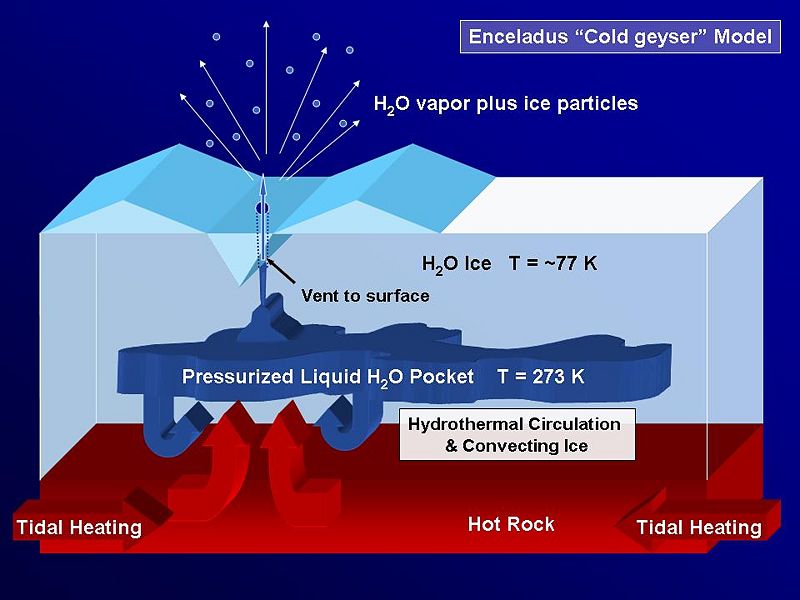File:Enceladus Cold Geyser Model.jpg

Original file (960 × 720 pixels, file size: 66 KB, MIME type: image/jpeg)
Summary
Model for cryovolcanic venting on Enceladus
Original caption
As Saturn's active moon Enceladus continues to spew icy particles into space, scientists struggle to understand the mechanics of what is going on beneath the fractured south polar terrain. This graphic illustrates key aspects of the model proposed by the Cassini imaging science team in a paper published in the journal Science on March 10, 2006.
The model shows how proposed underground reservoirs of pressurized liquid water above 273 degrees Kelvin (0 degrees Celsius) could fuel geysers that send jets of icy material into the skies above the moon's south pole. In the graphic, the vent to the surface pierces one of the "tiger stripe" fractures seen in Cassini views of the southern polar terrain (see PIA06247 for a look at the tiger stripes). Temperatures increase with depth.
Some combination of internal radioactive decay and flexing -- perhaps concentrated within the tiger stripe fractures and brought about by the particular characteristics of Enceladus' orbit--is implicated as the source of the heat creating the liquid reservoirs. However, it is not yet clear how the deep interior of Enceladus functions, nor whether the moon is fully differentiated (separated into layers, with rock at the center and ice outside).
The Cassini-Huygens mission is a cooperative project of NASA, the European Space Agency and the Italian Space Agency. The Jet Propulsion Laboratory, a division of the California Institute of Technology in Pasadena, manages the mission for NASA's Science Mission Directorate, Washington, D.C. The Cassini orbiter and its two onboard cameras were designed, developed and assembled at JPL. The imaging operations center is based at the Space Science Institute in Boulder, Colo.
For more information about the Cassini-Huygens mission visit <http://saturn.jpl.nasa.gov/home/index.cfm>. The Cassini imaging team homepage is at <http://ciclops.org>.
Copyright status
This image is credited to NASA and the Jet Propulsion Laboratory. Per JPL/NASA policy and applicable United States federal law, such images are in the public domain, or, if they are owned by individuals or institutions other than NASA or JPL, may be used for any journalistic, educational, or personal purpose (but not a commercial purpose) without further authorization. NASA and JPL images, other than their respective institutional logos, or photographs of actual persons, are not subject to copyright and may be used without additional permission, unless otherwise declared. For details, see the JPL Image Use Policy Declaration.
Source
NASA/JPL/Space Science Institute <http://photojournal.jpl.nasa.gov/jpeg/PIA07799.jpg>
File history
Click on a date/time to view the file as it appeared at that time.
| Date/Time | Thumbnail | Dimensions | User | Comment | |
|---|---|---|---|---|---|
| current | 19:51, 17 June 2008 |  | 960 × 720 (66 KB) | Temlakos (talk | contribs) | Model for cryovolcanic venting on Enceladus == Original caption == As Saturn's active moon Enceladus continues to spew icy particles into space, scientists struggle to understand the mechanics of what is going on beneath the fractured south polar terrain |
You cannot overwrite this file.
File usage
There are no pages that use this file.